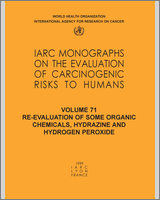NCBI Bookshelf. A service of the National Library of Medicine, National Institutes of Health.
IARC Working Group on the Evaluation of Carcinogenic Risks to Humans. Re-evaluation of Some Organic Chemicals, Hydrazine and Hydrogen Peroxide. Lyon (FR): International Agency for Research on Cancer; 1999. (IARC Monographs on the Evaluation of Carcinogenic Risks to Humans, No. 71.)
Data were last reviewed in IARC (1977) and the compound was classified in IARC Monographs Supplement 7 (1987).
1. Exposure Data
1.1. Chemical and physical data
1.1.1. Nomenclature
- Chem. Abstr. Serv. Reg. No.: 110-57-6
- Chem. Abstr. Name: trans-1,4-Dichloro-2-butene
1.1.2. Structural and molecular formulae and relative molecular mass

1.1.3. Physical properties (for details, see IARC, 1977)
- (a) Boiling-point: 155.5°C at 101 kPa
- (b) Melting-point: 1–3°C
- (c) Conversion factor: mg/m3 = 5.1 × ppm
1.2. Production and use
trans-1,4-Dichlorobutene has been produced commercially since about 1963 in several countries by the chlorination of 1,3-butadiene. By far its major use is as an intermediate in the manufacture of hexamethylenediamine and chloroprene (IARC, 1977).
2. Studies of Cancer in Humans
No data were available to the Working Group.
3. Studies of Cancer in Experimental Animals
trans-1,4-Dichlorobutene was tested for carcinogenicity in mice by skin application and by subcutaneous and intraperitoneal administration. It produced a low incidence of local sarcomas when injected subcutaneously or intraperitoneally (IARC, 1977).
4. Other Data Relevant to an Evaluation of Carcinogenicity and its Mechanisms
4.1. Absorption, distribution, metabolism and excretion
No data were available to the Working Group.
4.2. Toxic effects
No data were available to the Working Group.
4.3. Reproductive and developmental effects
No data were available to the Working Group.
4.4. Genetic and related effects
4.4.1. Humans
No data were available to the Working Group.
4.4.2. Experimental systems
trans-1,4-Dichlorobutene is mutagenic to bacteria (IARC, 1977).
5. Evaluation
No epidemiological data relevant to the carcinogenicity of trans-1,4-dichlorobutene were available.
There is inadequate evidence in experimental animals for the carcinogenicity of trans-1,4-dichlorobutene.
Overall evaluation
trans-1,4-Dichlorobutene is not classifiable as to its carcinogenicity to humans (Group 3).
6. References
- IARC (1977) IARC Monographs on the Evaluation of the Carcinogenic Risk of Chemicals to Man, Vol. 15, Some Fumigants, the Herbicides 2,4-D and 2,4,5-T, Chlorinated Dibenzodioxins and Miscellaneous Industrial Chemicals, Lyon, pp. 149–154 [PubMed: 330387]
- IARC (1987) IARC Monographs on the Evaluation of Carcinogenic Risks to Humans, Supplement 7, Overall Evaluations of Carcinogenicity: An Updating of IARC Monographs Volumes 1 to 42, Lyon, p. 62 [PubMed: 3482203]
- PubMedLinks to PubMed
- Pentachloroethane.[IARC Monogr Eval Carcinog Risk...]Pentachloroethane.. IARC Monogr Eval Carcinog Risks Hum. 1999; 71 Pt 3(PT 3):1519-23.
- Review 1,1,2,2-Tetrachloroethane.[IARC Monogr Eval Carcinog Risk...]Review 1,1,2,2-Tetrachloroethane.. IARC Monogr Eval Carcinog Risks Hum. 1999; 71 Pt 2(PT 2):817-27.
- Review 1,1,1,2-Tetrachloroethane.[IARC Monogr Eval Carcinog Risk...]Review 1,1,1,2-Tetrachloroethane.. IARC Monogr Eval Carcinog Risks Hum. 1999; 71 Pt 3(PT 3):1133-41.
- Review Toxicity of chloroprene, 1,3-dichlorobutene-2, and 1,4-dichlorobutene-2.[Environ Health Perspect. 1977]Review Toxicity of chloroprene, 1,3-dichlorobutene-2, and 1,4-dichlorobutene-2.Clary JJ. Environ Health Perspect. 1977 Dec; 21:269-74.
- Hexachloroethane.[Rep Carcinog. 2004]Hexachloroethane.. Rep Carcinog. 2004; 11:III140-1.
- trans-1,4-Dichlorobutene - Re-evaluation of Some Organic Chemicals, Hydrazine an...trans-1,4-Dichlorobutene - Re-evaluation of Some Organic Chemicals, Hydrazine and Hydrogen Peroxide
Your browsing activity is empty.
Activity recording is turned off.
See more...
